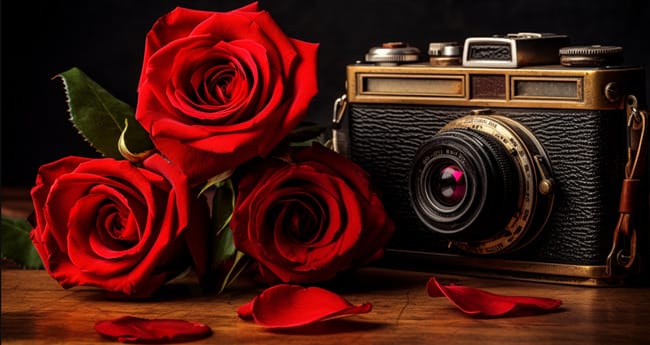
Welcome to our exploration of the fascinating world of symbols in photography.
We, as photographers, have the amazing ability to capture moments and tell stories through our lenses.
But did you know that images can hold hidden meanings conveyed through symbols?
Symbols have the power to evoke emotions, convey ideas, and add depth to our photographs.
They can be found in various forms, such as objects, animals, colors, shapes, and even locations.
By understanding the language of symbols in photography, we can enhance our storytelling abilities and invite viewers to interpret our images in a more profound and meaningful way.
Join us on this journey as we unravel the secrets behind the symbols in photography and discover how they can transform our visual narratives.
Key Takeaways
- Symbolism adds depth and meaning to photographs.
- Understanding symbolism can enhance the viewer’s interpretation of a photograph.
- Symbols have different meanings in different contexts.
- Animals have a continuous presence in symbology and visual art.
The Role of Symbols in Photography

In exploring the role of symbols in photography, we can understand how they contribute to the overall meaning and impact of an image.
Symbols serve as visual cues that convey deeper meanings and evoke specific emotions.
Understanding the Concept of Symbolism in Photography
Through the use of symbols, we can convey deeper meanings and evoke emotions in our photographs. Symbolism in photography allows us to go beyond the surface level and communicate messages that resonate with viewers on a more profound level.
By incorporating symbols into our images, we can tap into the collective understanding and cultural associations that these symbols carry.
Symbols have the power to transcend language barriers and connect with people on a universal level. They can represent abstract concepts, emotions, or ideas that may be difficult to express through words alone.
Symbols in photography add layers of complexity and invite viewers to interpret and engage with the image on a deeper level.
Exploring the use of common symbols in photography allows us to understand how these symbols can be employed to convey specific meanings and enhance the visual storytelling in our photographs.
Related: Engraving Ideas for Best Friend
Exploring the Use of Common Symbols in Photography
By exploring the use of common symbols in photography, we can uncover the role these symbols play in enhancing the visual storytelling of our images.
Symbols, whether they’re objects, animals, colors, or shapes, carry cultural and universal meanings that can evoke emotions and convey messages to the viewers. These symbols act as a visual language, allowing photographers to communicate their intentions and create a deeper connection with their audience.
How to Incorporate Symbolism to Convey Deeper Meanings in Images
How can photographers incorporate symbolism to convey deeper meanings in their images?
One way is by carefully arranging objects together in a composition to create new, deeper meanings. Different plants, animals, and elements have their symbolic meanings that can be utilized to evoke emotional responses in the audience.
Here are two sub-lists of how symbolism can be used to convey deeper meanings:
- Symbolism in Nature:
- Using fire to represent passion and rebirth can evoke feelings of intensity and transformation.
- Incorporating water to symbolize power and wisdom can create a sense of tranquility and contemplation.
- Symbolism in Color:
- Utilizing the color red, which is associated with heat and conflict, can evoke a sense of tension and confrontation.
- Incorporating the color yellow, which symbolizes the sun and positive emotions, can evoke feelings of warmth and happiness.
The Impact of Symbolic Colors in Photography
Symbolic colors play a significant role in photography, adding depth and meaning to images. Colors have the power to evoke emotions and convey messages without the need for words.
For example, green often symbolizes nature, growth, and tranquility, while bright red can signify danger or passion.
However, the impact of symbolic colors can vary depending on cultural experiences and personal associations. What one individual perceives as calming, another might interpret as luxurious.
Understanding the symbolism of colors allows photographers to intentionally use specific hues to enhance the intended message of their images.
By strategically incorporating symbolic colors into their compositions, photographers can create visually compelling photographs that resonate with viewers on a deeper level.
Using Objects as Symbols to Evoke Emotions in Photography
Objects in photography have the power to evoke emotions and convey meaning, adding depth and symbolism to images. By using objects as symbols, photographers can create a visual language that resonates with the audience.
Here are two ways in which objects can evoke an emotional response in photography:
- Contextual symbolism:
- Placing an object in a specific context can evoke emotions associated with that context. For example, a flower placed on a gravestone can symbolize grief and loss.
- Using objects that have cultural or personal significance can elicit specific emotions. A wedding ring, for instance, can symbolize love and commitment.
- Metaphorical symbolism:
- Objects can be used metaphorically to represent abstract concepts or emotions. A broken mirror can symbolize a shattered self-image or a fractured identity.
- An object can also be used as a visual metaphor to convey a specific emotion. A solitary chair in an empty room can symbolize loneliness and isolation.
Symbolism Through Colors and Objects

Let’s now explore the fascinating world of symbolism through colors and objects in photography.
Color plays a powerful role in conveying emotions and themes, and we’ll delve into the symbolic use of colors such as red, yellow, orange, and pink.
Additionally, we’ll discuss how objects can be used as symbols to represent ideas and emotions, including the use of flowers, fruits and vegetables, animals, and instruments in photography.
Exploring the Symbolic Use of Color in Photography
Color plays a significant role in photography, allowing photographers to convey deeper meanings and evoke specific emotions through the use of various hues.
When it comes to symbolism through color in photography, there are two key ways in which colors can evoke an emotional response in the audience:
- Color associations: Different colors have different cultural and personal associations, which can evoke specific emotions. For example, red is often associated with passion and love, while blue is associated with calmness and tranquility.
- Color contrast: The contrast between different colors within an image can create visual tension and evoke emotions. For example, a photograph with a stark contrast between red and blue can symbolize the clash of opposing forces or ideas.
Understanding the symbolic use of color in photography allows photographers to create more impactful and meaningful images.
Using Flowers as Symbols to Represent Ideas and Emotions in Photography
Flowers serve as powerful symbols in photography, representing a range of ideas and emotions.
Throughout history, flowers have been used to convey messages of youth, beauty, innocence, and vulnerability. In the Victorian era, flowers were even assigned specific meanings, creating a language of flowers.
However, as photography evolved, the symbolism of flowers also changed. Artists like Robert Mapplethorpe challenged traditional associations by using flowers as symbols of sensuality and aggression.
By juxtaposing the delicate beauty of flowers with the human body, Mapplethorpe pushed the boundaries of societal norms and critiqued the audience’s perception of sexuality.
Today, flowers continue to be a popular subject in photography, allowing artists to express a wide range of emotions and ideas through their vibrant colors, delicate forms, and intricate details.
Photographing Fruits and Vegetables as Symbolic Elements
As we explore the topic of symbolism in photography, one fascinating aspect to consider is the use of fruits and vegetables as symbolic elements in capturing deeper meanings through their colors and objects.
Fruits and vegetables evoke a sense of vitality and growth, connecting viewers to the natural world and the cycle of life.
The vibrant colors of fruits and vegetables can evoke emotions such as joy, freshness, and abundance, creating a visually appealing and emotionally resonant image.
By incorporating fruits and vegetables into photographs, photographers can convey messages about health, nourishment, sustainability, and the interconnectedness of humans and nature.
The choice of specific fruits and vegetables can further enhance the symbolism, as each has its own cultural and symbolic associations.
Capturing Animals as Symbols in Photography
Now let’s explore how animals can be captured as symbols in photography, using their colors and objects to convey deeper meanings.
Animals have always played a significant role in art, serving as powerful symbols of various themes and concepts.
Cats, for example, often symbolize freedom, wit, and grace, while horses signify nobility and add dynamism to a picture.
Pigeons are associated with peace and freedom, while eagles and hawks convey strength and power.
By incorporating animals into our photographs, we can tap into the rich symbolism they carry, amplifying the messages we wish to convey.
Whether through the colors of their fur, the objects they interact with, or the settings they inhabit, animals provide us with a visual language that can add depth and meaning to our photographs.
Using Symbolism to Convey Messages through Visual Art
Colors and objects hold immense power in evoking emotions and creating connections with the audience. Through careful selection and placement, photographers can effectively communicate their intended messages.
Colors:
- Red: Symbolizes heat, fire, and blood, often indicating tension or conflict.
- Yellow and Orange: Represent warmth, delight, and positive emotions.
- Pink: Associated with innocence, sympathy, and femininity, conveying a sense of lightness and carelessness.
Objects:
- Mirrors: Symbolize self-reflection, honesty, and self-awareness, adding depth to the composition.
- Instruments: Convey sound, music, and emotions, capturing the essence of a moment.
Symbolism Across Different Themes and Cultures

When exploring symbolism across different themes and cultures in photography, it’s important to consider the symbolic meanings associated with colors and objects.
For example, pink is often associated with innocence and femininity, while yellow represents the sun and positive emotions.
Orange signifies warmth and delight, while black and white evoke sentimentality and focus on emotions.
The Symbolic Meanings of Pink, Yellow, Orange, and Black and White in Photography
As we explore the symbolic meanings of pink, yellow, orange, and black and white in photography, we discover the diverse interpretations that these colors hold across different themes and cultures.
Pink:
- Evokes feelings of innocence, sympathy, and femininity
- Radiates lightness and carelessness associated with childhood
Yellow and Orange:
- Evoke positive emotions such as warmth and delight
- Announce the end of winter and represent carelessness and positivity
Black and White:
- Represents age and sentimentality
- Focuses on emotions and realism
Understanding the symbolic meanings of these colors adds depth and enhances the viewer’s interpretation of a photograph.
Pink can convey a sense of innocence or playfulness, while yellow and orange evoke warmth and happiness.
On the other hand, black and white can create a nostalgic or dramatic atmosphere.
By using these colors intentionally, photographers can evoke specific emotions and meanings in their images, allowing viewers to engage with the photograph on a deeper level.
Exploring Cultural Associations and Symbolism in Photography
Throughout different themes and cultures, symbolism in photography has been shaped by diverse cultural associations and interpretations.
Cultural symbols and their meanings vary greatly across different societies and regions, resulting in the creation of unique visual languages within photography.
For example, in Western cultures, the color white often symbolizes purity and innocence, while in some Eastern cultures, it represents mourning and death.
Similarly, certain animals hold specific cultural significance and symbolism. The tiger, for instance, is revered as a symbol of power and strength in many Eastern cultures, while in Western cultures, it may represent danger or aggression.
Reinterpreting Medieval Symbolism in Modern Photography
We can reinterpret medieval symbolism in modern photography to explore the rich tapestry of symbols across different themes and cultures.
By incorporating elements from the medieval period into contemporary photographic compositions, we can create a visual dialogue that transcends time and connects us to the deep-rooted symbolism of the past.
This reinterpretation allows us to evoke an emotional response in the audience through the following:
Evoke a sense of mystery and spirituality:
- Incorporate medieval religious symbols, such as crosses or halos, to create a sense of transcendence and divine presence.
- Utilize dark and atmospheric lighting to evoke a sense of awe and reverence.
Evoke a sense of chivalry and romance:
- Incorporate medieval armor or weaponry to evoke a sense of nobility and honor.
- Utilize soft and warm lighting to create a romantic atmosphere reminiscent of medieval courtly love.
Symbolism in Fine Art Photography: Depicting Common Symbols with Deeper Meanings
Symbolism in fine art photography allows photographers to convey complex ideas and emotions through visual cues.
By incorporating symbols into their photographs, artists can add layers of meaning and invite viewers to engage with the images on a deeper level.
These symbols can range from objects and animals to colors and shapes, each carrying its own significance and cultural associations.
By understanding the symbolism behind these common symbols, viewers can gain a greater appreciation for the artist’s intention and the message they’re trying to convey.
Expressing Symbolism through Fruit and Vegetable Photography
Symbolism in fruit and vegetable photography transcends cultural boundaries and explores the deeper meanings associated with these natural elements.
Through the use of fruits and vegetables as visual symbols, photographers can evoke powerful emotions and convey profound messages to their audience.
Here are two sub-lists that highlight the emotional impact of symbolism in this genre:
Nourishment and Abundance:
- Images of ripe, luscious fruits can evoke feelings of satisfaction, nourishment, and abundance.
- Photographs featuring a bountiful harvest or a table overflowing with vegetables can evoke a sense of gratitude and contentment.
Transience and Decay:
- Photographs of decaying or rotting fruits and vegetables can symbolize the transience of life and the inevitability of decay.
- By capturing the beauty in the imperfections and the fleeting nature of these natural elements, photographers can evoke feelings of reflection, acceptance, and the circle of life.
Through the art of fruit and vegetable photography, photographers have the power to communicate universal themes and emotions, allowing viewers to connect with these symbols on a deeper level.
Conclusion
As we come to the end of our exploration into symbolism in photography, we can now appreciate the profound impact these hidden meanings can have on our images.
Symbols allow us to transcend the literal and delve into the realm of emotions and ideas, adding depth and layers to our photographs.
By understanding the language of symbols, we can unlock new levels of storytelling and invite viewers to interpret our images in a more meaningful and personal way.
Next time you pick up your camera, remember the power that symbols hold and let them guide your artistic journey.
FAQ
What is symbolism in photography?
Symbolism in photography refers to the use of symbolic elements such as objects, colors, and composition to convey a deeper meaning or idea within an image. Photographers associate these symbols with cultural, emotional, or universal meanings to convey a specific message within their photographs.
How do photographers incorporate symbols in their images?
Photographers incorporate symbols in their images through careful selection of objects, colors, and composition to convey a particular theme or concept. They use symbolism to express specific ideas or emotions within their photographs and evoke meanings that go beyond the literal interpretation of the image.
What are some common symbols used in photography?
Common symbols used in photography include animals, flowers, fruits, colors, and objects that symbolize concepts such as freedom, innocence, wealth, and joy. These symbols are often associated with specific meanings and are used by photographers to convey these ideas within their visual art.





